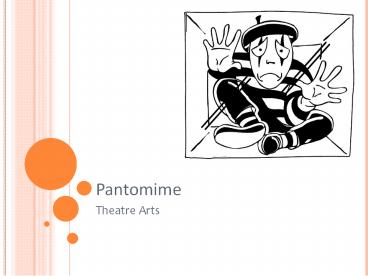Pantomime - PowerPoint PPT Presentation
Title:
Pantomime
Description:
Pantomime Theatre Arts What is Pantomime? Acting without talking Comes from the Greek word pantominios, which means all imitator (imitate all) Why ... – PowerPoint PPT presentation
Number of Views:576
Avg rating:3.0/5.0
Title: Pantomime
1
Pantomime
- Theatre Arts
2
What is Pantomime?
- Acting without talking
- Comes from the Greek word pantominios, which
means all imitator (imitate all)
3
Why Study Pantomime?
- It is the first phase of acting
- Body
- Voice
- Mind
- The language of action is universal
- ACTIONS SPEAK LOUDER THAN WORDS!
4
History of Pantomime
- Oldest means of dramatic expression
- Successful hunts
- Victorious battles
- First actors used to express their hopes for the
future, along with - Dance
- Chants
- Ancient Rome half-time shows
- Elizabethan period dumb shows
5
History of Pantomime
- Silent movies
- Charlie Chaplin (early 1900s)
- Marcel Marceau (1950s)
- the language of the heart
6
Principles of Pantomime
- Chest is the key
- Positive emotions high, expanded, free, broad,
animated gestures - Negative emotions tense, contracted, restricted
gestures - Use upstage arm
- Avoid covering your face while expressing emotion
- Direct your story to your audience
- All movement should be clearly motivated
- Use posture/movements expected of your character
- Concentrate!
- Practice!
7
Principles of Pantomime
- Creating an object in pantomime
- Visualize the object. See it in your mind.
- Approach the object. Move toward it.
- Take the object. Make contact with it.
- Tell the audience its location, size, shape,
weight. - Release the object. Let go.
8
DOs and DONTs
- DO
- DO exaggerate facial expression
- DO show the shape, size, weight of objects
- DO focus fully on the task
- DO show the audience who you are, where you are
and what is happening - DO plan a beginning, middle and end
- DO include conflict or a problem
- DONT
- DONT mouth words
- DONT make any noise
- DONT use props
- DONT include body contact
- DONT include violence, weapons, etc.
9
Gesture Practice
- Relief (Phew!)
- Impatience (Youre late!)
- Calling someone over (Come here!)
- No, thank you.
- Excitement (I cant wait!)
- Begging (Pretty please?!?)
- Approval (Thats great!)
10
Object Practice
- Talk on the phone
- Open a can of soda
- Type on the computer
- Pick up a pencil
- Pick up a bowling ball
11
Individual Pantomimes
- Keep it Simple! Examples
- Walk along the street and get bubble gum stuck to
the bottom of your shoe. - Try to open your locker. It is jammed.
- Wash your face and get soap in your eyes. Look
for a towel. - Put on a pair of shoes that are too tight.
- You have been robbed and your hands are tied
behind your back. Try to call the police on the
telephone. - You cant find the right key to open the lock on
the door. - Drink a large glass of water and then discover
you have swallowed a bug. - Eat a piece of candy and then realize you ate a
piece of cat food by mistake.















![[PDF] DOWNLOAD Dickens's Clowns: Charles Dickens, Joseph Grimaldi and PowerPoint PPT Presentation](https://s3.amazonaws.com/images.powershow.com/10064411.th0.jpg?_=20240626046)



![⚡[PDF]✔ It's a Drag: Cross-Dressing in Performance PowerPoint PPT Presentation](https://s3.amazonaws.com/images.powershow.com/10053405.th0.jpg?_=202406111110)

![[PDF]❤️DOWNLOAD⚡️ It's a Drag: Cross-Dressing in Performance PowerPoint PPT Presentation](https://s3.amazonaws.com/images.powershow.com/10045817.th0.jpg?_=202406031212)

![[PDF]❤️DOWNLOAD⚡️ It's a Drag: Cross-Dressing in Performance PowerPoint PPT Presentation](https://s3.amazonaws.com/images.powershow.com/10046829.th0.jpg?_=20240604125)







